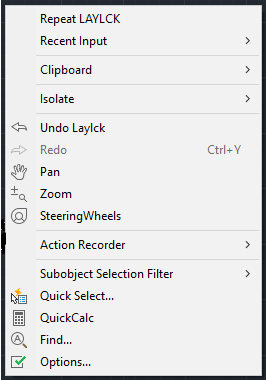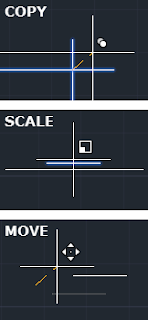



Is the amount of work you have done since the last save worth rescuing? That will depend on how much work you did. After a few mins longer you may want to weigh up whether or not it is worth trying to regain control at all. After a minute or so, you could try a few taps on the Escape key – sometimes you can cancel the command and regain control. Wait!!! Do not mash the keys – however tempting that may be! Doing so will only make it take longer. One particularly prolific bug that I’ve had problems with is the Scale List Bug. Try where possible to work locally, but only where doing so does not undermine whatever document management system you have in place (you do have a structured and coherent document management system. Working on drawings that are saved on some external network has been known to suffer performance issues. So for very small drawings, its fine to use SHIFT+MOUSEWHEEL, but for everything else use 3DO. If you use the SHIFT+MOUSEWHEEL method, you’ll make AutoCAD® prepare for 3D orbitting each time you use it, which can be very time consuming on larger drawings. AutoCAD® needs to prepare for 3D orbitting, and if you’re planning on manipulating the drawing a bit, you only want to make AutoCAD® hang for this preparation once. When working in 3D, you might be tempted to avoid the 3DORBIT command completely in favour of the SHIFT+MOUSEWHEEL, but there is a reason you should generally use the 3DO command instead. Take a look at my post on the RECTANG command to see what I mean. This allows me to then hatch later by selecting a boundary, eliminating the need to pick points, potentially making AutoCAD® hang. For example, where possible I use closed polylines instead of lines. I personally always try to draw in a way that makes hatching easy. A lot of people routinely use the pick-points option for defining a hatch boundary. Hatching is one of the main ones, but again, a little know-how can avoid this. There are a few commands that more commonly cause AutoCAD® to freeze than others. But again, picking the erase command first and then the entities sends a clearer message with a very noticeable difference in performance when working with large selections. An extension of this is to get out of the habit of using the Delete key for erasing entities. This instruction is much clearer and skips out a lot that we’re not interested in. This is vague, so AutoCAD® has to prepare for anything. However by invoking the command first and making a selection afterwards you’re saying “I only care about performing this action – these are the entities I want to perform it on”. By selecting first you’re saying to AutoCAD® “Here are some entities that I am interested in – prepare them for me to use in any way”. This sends a clearer instruction to AutoCAD®, and it is dealt with more quickly than if we make the selection first. Make sure you select commands before you make a selection. There are ways of working that allow us to drastically reduce the frequency of AutoCAD® freezing when working with a large selection. The time that this takes is proportional with the amount of things selected, so you can see that simply selecting objects can be the cause of AutoCAD® freezing. So, if for example you have the properties window on your screen anywhere, even if it is docked with the auto-hide feature enabled, all the data in the properties window needs to be updated with correct information. When a selection is made, any on screen information that relates to your active selection needs to be updated otherwise you’ll be working from incorrect information. This can sometimes leave us gazing at an hourglass thinking “I didn’t ask you to do anything! Why are you freezing on me!?”. Odd as this may seem, there is a reason for it. What can sometimes be unexpected is when AutoCAD® freezes when we have merely selected the objects without doing anything to them. The first and most obvious reason for AutoCAD® freezing is when we do things to a very large selection. How many times have you been working in AutoCAD®, and then suddenly it freezes on you? Panic sets in, as you try to remember the last time you saved… You wait… and wait… and… thankfully AutoCAD® un-freezes, this time…īut what actually is the cause of AutoCAD® freezing? It depends – there are many potential reasons for AutoCAD® freezing, but some can be avoided completely with a little understanding of what’s actually happening.


 0 kommentar(er)
0 kommentar(er)
